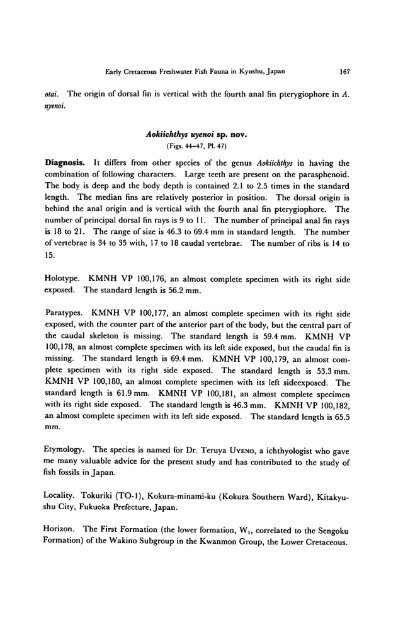Early Cretaceous Freshwater Fish Fauna in Kyushu, Japan
Early Cretaceous Freshwater Fish Fauna in Kyushu, Japan
Early Cretaceous Freshwater Fish Fauna in Kyushu, Japan
Create successful ePaper yourself
Turn your PDF publications into a flip-book with our unique Google optimized e-Paper software.
<strong>Early</strong> <strong>Cretaceous</strong> <strong>Freshwater</strong> <strong>Fish</strong> <strong>Fauna</strong> <strong>in</strong> <strong>Kyushu</strong>, <strong>Japan</strong> 167<br />
otai. The orig<strong>in</strong> of dorsal f<strong>in</strong> is vertical with the fourth anal f<strong>in</strong> pterygiophore <strong>in</strong> A.<br />
uyenoi.<br />
Aokiichthys uyenoi sp. nov.<br />
(Figs. 44-47, PI. 47)<br />
Diagnosis. It differs from other species of the genus Aokiichthys <strong>in</strong> hav<strong>in</strong>g the<br />
comb<strong>in</strong>ation of follow<strong>in</strong>g characters. Large teeth are present on the parasphenoid.<br />
The body is deep and the body depth is conta<strong>in</strong>ed 2.1 to 2.5 times <strong>in</strong> the standard<br />
length. The median f<strong>in</strong>s are relatively posterior <strong>in</strong> position. The dorsal orig<strong>in</strong> is<br />
beh<strong>in</strong>d the anal orig<strong>in</strong> and is vertical with the fourth anal f<strong>in</strong> pterygiophore. The<br />
number of pr<strong>in</strong>cipal dorsal f<strong>in</strong> rays is 9 to 11. The number of pr<strong>in</strong>cipal anal f<strong>in</strong> rays<br />
is 18 to 21. The range of size is 46.3 to 69.4 mm <strong>in</strong> standard length. The number<br />
ofvertebrae is 34 to 35 with, 17 to 18 caudal vertebrae. The number of ribs is 14 to<br />
15.<br />
Holotype.<br />
exposed.<br />
KMNH VP 100,176, an almost complete specimen with its right side<br />
The standard length is 56.2 mm.<br />
Paratypes. KMNH VP 100,177, an almost complete specimen with its right side<br />
exposed, with the counter part of the anterior part of the body, but the central part of<br />
the caudal skeleton is miss<strong>in</strong>g. The standard length is 59.4 mm. KMNH VP<br />
100,178, an almost completespecimen with its leftside exposed, but the caudal f<strong>in</strong> is<br />
miss<strong>in</strong>g. The standard length is 69.4 mm. KMNH VP 100,179, an almost com<br />
plete specimen with its right side exposed. The standard length is 53.3 mm.<br />
KMNH VP 100,180, an almost complete specimen with its left sideexposed. The<br />
standard length is 61.9 mm. KMNH VP 100,181, an almost complete specimen<br />
with its right side exposed. The standard length is 46.3 mm. KMNH VP 100,182,<br />
an almost complete specimen with its left side exposed. The standard length is 65.5<br />
mm.<br />
Etymology. The species is named for Dr. Teruya Uyeno, a ichthyologist who gave<br />
me many valuable advice for the present study and has contributed to the study of<br />
fish fossils <strong>in</strong> <strong>Japan</strong>.<br />
Locality. Tokuriki (TO-1), Kokura-m<strong>in</strong>ami-ku (Kokura Southern Ward), Kitakyu<br />
shu City, Fukuoka Prefecture, <strong>Japan</strong>.<br />
Horizon. The First Formation (the lower formation, W,, correlated to the Sengoku<br />
Formation) ofthe Wak<strong>in</strong>o Subgroup <strong>in</strong> the Kwanmon Group, the Lower <strong>Cretaceous</strong>.

















